Liangyu Chen
POLYCHARTQA: Benchmarking Large Vision-Language Models with Multilingual Chart Question Answering
Jul 16, 2025Abstract:Charts are a universally adopted medium for interpreting and communicating data. However, existing chart understanding benchmarks are predominantly English-centric, limiting their accessibility and applicability to global audiences. In this paper, we present PolyChartQA, the first large-scale multilingual chart question answering benchmark covering 22,606 charts and 26,151 question-answering pairs across 10 diverse languages. PolyChartQA is built using a decoupled pipeline that separates chart data from rendering code, allowing multilingual charts to be flexibly generated by simply translating the data and reusing the code. We leverage state-of-the-art LLM-based translation and enforce rigorous quality control in the pipeline to ensure the linguistic and semantic consistency of the generated multilingual charts. PolyChartQA facilitates systematic evaluation of multilingual chart understanding. Experiments on both open- and closed-source large vision-language models reveal a significant performance gap between English and other languages, especially low-resource ones with non-Latin scripts. This benchmark lays a foundation for advancing globally inclusive vision-language models.
OpenThoughts: Data Recipes for Reasoning Models
Jun 05, 2025Abstract:Reasoning models have made rapid progress on many benchmarks involving math, code, and science. Yet, there are still many open questions about the best training recipes for reasoning since state-of-the-art models often rely on proprietary datasets with little to no public information available. To address this, the goal of the OpenThoughts project is to create open-source datasets for training reasoning models. After initial explorations, our OpenThoughts2-1M dataset led to OpenThinker2-32B, the first model trained on public reasoning data to match DeepSeek-R1-Distill-32B on standard reasoning benchmarks such as AIME and LiveCodeBench. We then improve our dataset further by systematically investigating each step of our data generation pipeline with 1,000+ controlled experiments, which led to OpenThoughts3. Scaling the pipeline to 1.2M examples and using QwQ-32B as teacher yields our OpenThoughts3-7B model, which achieves state-of-the-art results: 53% on AIME 2025, 51% on LiveCodeBench 06/24-01/25, and 54% on GPQA Diamond - improvements of 15.3, 17.2, and 20.5 percentage points compared to the DeepSeek-R1-Distill-Qwen-7B. All of our datasets and models are available on https://openthoughts.ai.
Step-Video-TI2V Technical Report: A State-of-the-Art Text-Driven Image-to-Video Generation Model
Mar 14, 2025Abstract:We present Step-Video-TI2V, a state-of-the-art text-driven image-to-video generation model with 30B parameters, capable of generating videos up to 102 frames based on both text and image inputs. We build Step-Video-TI2V-Eval as a new benchmark for the text-driven image-to-video task and compare Step-Video-TI2V with open-source and commercial TI2V engines using this dataset. Experimental results demonstrate the state-of-the-art performance of Step-Video-TI2V in the image-to-video generation task. Both Step-Video-TI2V and Step-Video-TI2V-Eval are available at https://github.com/stepfun-ai/Step-Video-TI2V.
BIOMEDICA: An Open Biomedical Image-Caption Archive, Dataset, and Vision-Language Models Derived from Scientific Literature
Jan 14, 2025Abstract:The development of vision-language models (VLMs) is driven by large-scale and diverse multimodal datasets. However, progress toward generalist biomedical VLMs is limited by the lack of annotated, publicly accessible datasets across biology and medicine. Existing efforts are restricted to narrow domains, missing the full diversity of biomedical knowledge encoded in scientific literature. To address this gap, we introduce BIOMEDICA, a scalable, open-source framework to extract, annotate, and serialize the entirety of the PubMed Central Open Access subset into an easy-to-use, publicly accessible dataset. Our framework produces a comprehensive archive with over 24 million unique image-text pairs from over 6 million articles. Metadata and expert-guided annotations are also provided. We demonstrate the utility and accessibility of our resource by releasing BMCA-CLIP, a suite of CLIP-style models continuously pre-trained on the BIOMEDICA dataset via streaming, eliminating the need to download 27 TB of data locally. On average, our models achieve state-of-the-art performance across 40 tasks - spanning pathology, radiology, ophthalmology, dermatology, surgery, molecular biology, parasitology, and cell biology - excelling in zero-shot classification with a 6.56% average improvement (as high as 29.8% and 17.5% in dermatology and ophthalmology, respectively), and stronger image-text retrieval, all while using 10x less compute. To foster reproducibility and collaboration, we release our codebase and dataset for the broader research community.
C3oT: Generating Shorter Chain-of-Thought without Compromising Effectiveness
Dec 16, 2024



Abstract:Generating Chain-of-Thought (CoT) before deriving the answer can effectively improve the reasoning capabilities of large language models (LLMs) and significantly improve the accuracy of the generated answer. However, in most cases, the length of the generated CoT is much longer than the desired final answer, which results in additional decoding costs. Furthermore, existing research has discovered that shortening the reasoning steps in CoT, even while preserving the key information, diminishes LLMs' abilities. These phenomena make it difficult to use LLMs and CoT in many real-world applications that only require the final answer and are sensitive to latency, such as search and recommendation. To reduce the costs of model decoding and shorten the length of the generated CoT, this paper presents $\textbf{C}$onditioned $\textbf{C}$ompressed $\textbf{C}$hain-of-$\textbf{T}$hought (C3oT), a CoT compression framework that involves a compressor to compress an original longer CoT into a shorter CoT while maintaining key information and interpretability, a conditioned training method to train LLMs with both longer CoT and shorter CoT simultaneously to learn the corresponding relationships between them, and a conditioned inference method to gain the reasoning ability learned from longer CoT by generating shorter CoT. We conduct experiments over four datasets from arithmetic and commonsense scenarios, showing that the proposed method is capable of compressing the length of generated CoT by up to more than 50% without compromising its effectiveness.
Diversify and Conquer: Diversity-Centric Data Selection with Iterative Refinement
Sep 17, 2024Abstract:Finetuning large language models on instruction data is crucial for enhancing pre-trained knowledge and improving instruction-following capabilities. As instruction datasets proliferate, selecting optimal data for effective training becomes increasingly important. This work addresses the question: How can we determine the optimal subset of data for effective training? While existing research often emphasizes local criteria like instance quality for subset selection, we argue that a global approach focused on data diversity is more critical. Our method employs k-means clustering to ensure the selected subset effectively represents the full dataset. We propose an iterative refinement method inspired by active learning techniques to resample instances from clusters, reassessing each cluster's importance and sampling weight in every training iteration. This approach reduces the effect of outliers and automatically filters out clusters containing low-quality data. Through extensive evaluation across natural language reasoning, general world knowledge, code and math reasoning tasks, and by fine-tuning models from various families, we observe consistent improvements, achieving a 7% increase over random selection and a 3.8% improvement over state-of-the-art sampling methods. Our work highlights the significance of diversity-first sampling when finetuning LLMs to enhance performance across a broad array of evaluation tasks. Our code is available at https://github.com/for-ai/iterative-data-selection.
MMLongBench-Doc: Benchmarking Long-context Document Understanding with Visualizations
Jul 01, 2024Abstract:Understanding documents with rich layouts and multi-modal components is a long-standing and practical task. Recent Large Vision-Language Models (LVLMs) have made remarkable strides in various tasks, particularly in single-page document understanding (DU). However, their abilities on long-context DU remain an open problem. This work presents MMLongBench-Doc, a long-context, multi-modal benchmark comprising 1,062 expert-annotated questions. Distinct from previous datasets, it is constructed upon 130 lengthy PDF-formatted documents with an average of 49.4 pages and 20,971 textual tokens. Towards comprehensive evaluation, answers to these questions rely on pieces of evidence from (1) different sources (text, image, chart, table, and layout structure) and (2) various locations (i.e. page number). Moreover, 33.2% of the questions are cross-page questions requiring evidence across multiple pages. 22.8% of the questions are designed to be unanswerable for detecting potential hallucinations. Experiments on 14 LVLMs demonstrate that long-context DU greatly challenges current models. Notably, the best-performing model, GPT-4o, achieves an F1 score of only 42.7%, while the second-best, GPT-4V, scores 31.4%. Furthermore, 12 LVLMs (all except GPT-4o and GPT-4V) even present worse performance than their LLM counterparts which are fed with lossy-parsed OCR documents. These results validate the necessity of future research toward more capable long-context LVLMs. Project Page: https://mayubo2333.github.io/MMLongBench-Doc
MMInA: Benchmarking Multihop Multimodal Internet Agents
Apr 15, 2024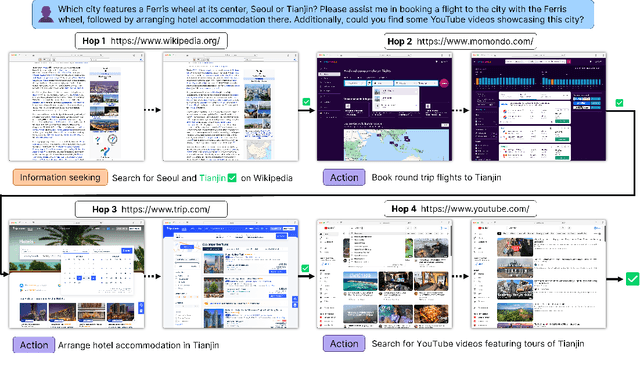

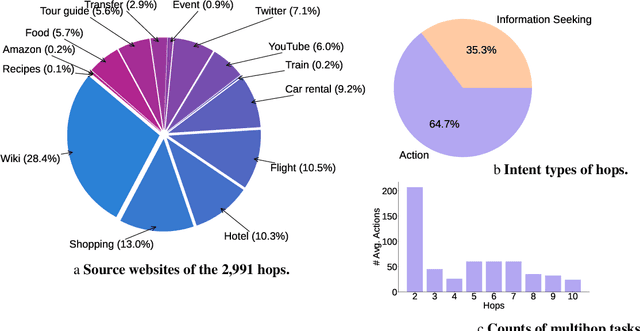
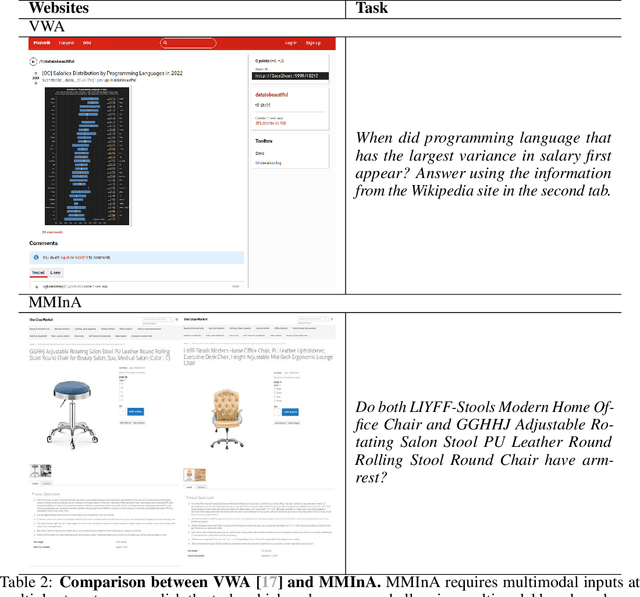
Abstract:Autonomous embodied agents live on an Internet of multimedia websites. Can they hop around multimodal websites to complete complex user tasks? Existing benchmarks fail to assess them in a realistic, evolving environment for their embodiment across websites. To answer this question, we present MMInA, a multihop and multimodal benchmark to evaluate the embodied agents for compositional Internet tasks, with several appealing properties: 1) Evolving real-world multimodal websites. Our benchmark uniquely operates on evolving real-world websites, ensuring a high degree of realism and applicability to natural user tasks. Our data includes 1,050 human-written tasks covering various domains such as shopping and travel, with each task requiring the agent to autonomously extract multimodal information from web pages as observations; 2) Multihop web browsing. Our dataset features naturally compositional tasks that require information from or actions on multiple websites to solve, to assess long-range reasoning capabilities on web tasks; 3) Holistic evaluation. We propose a novel protocol for evaluating an agent's progress in completing multihop tasks. We experiment with both standalone (multimodal) language models and heuristic-based web agents. Extensive experiments demonstrate that while long-chain multihop web tasks are easy for humans, they remain challenging for state-of-the-art web agents. We identify that agents are more likely to fail on the early hops when solving tasks of more hops, which results in lower task success rates. To address this issue, we propose a simple memory augmentation approach replaying past action trajectories to reflect. Our method significantly improved both the single-hop and multihop web browsing abilities of agents. See our code and data at https://mmina.cliangyu.com
Aurora-M: The First Open Source Multilingual Language Model Red-teamed according to the U.S. Executive Order
Mar 30, 2024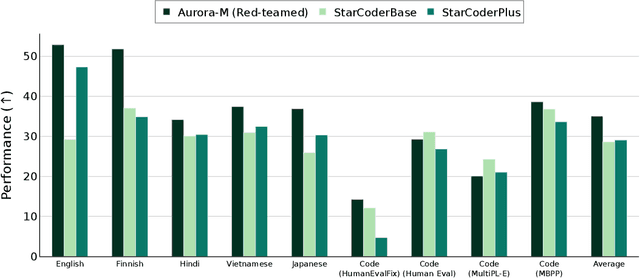

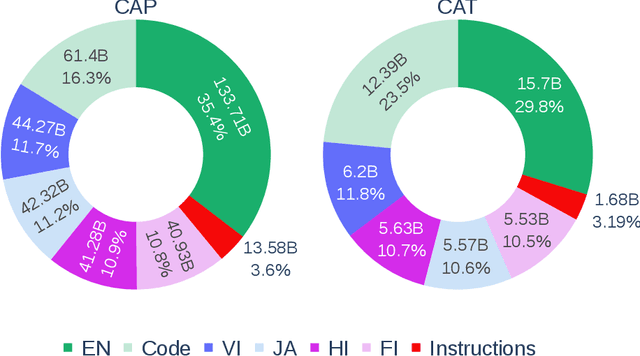

Abstract:Pretrained language models underpin several AI applications, but their high computational cost for training limits accessibility. Initiatives such as BLOOM and StarCoder aim to democratize access to pretrained models for collaborative community development. However, such existing models face challenges: limited multilingual capabilities, continual pretraining causing catastrophic forgetting, whereas pretraining from scratch is computationally expensive, and compliance with AI safety and development laws. This paper presents Aurora-M, a 15B parameter multilingual open-source model trained on English, Finnish, Hindi, Japanese, Vietnamese, and code. Continually pretrained from StarCoderPlus on 435 billion additional tokens, Aurora-M surpasses 2 trillion tokens in total training token count. It is the first open-source multilingual model fine-tuned on human-reviewed safety instructions, thus aligning its development not only with conventional red-teaming considerations, but also with the specific concerns articulated in the Biden-Harris Executive Order on the Safe, Secure, and Trustworthy Development and Use of Artificial Intelligence. Aurora-M is rigorously evaluated across various tasks and languages, demonstrating robustness against catastrophic forgetting and outperforming alternatives in multilingual settings, particularly in safety evaluations. To promote responsible open-source LLM development, Aurora-M and its variants are released at https://huggingface.co/collections/aurora-m/aurora-m-models-65fdfdff62471e09812f5407 .
From LLM to Conversational Agent: A Memory Enhanced Architecture with Fine-Tuning of Large Language Models
Jan 05, 2024Abstract:This paper introduces RAISE (Reasoning and Acting through Scratchpad and Examples), an advanced architecture enhancing the integration of Large Language Models (LLMs) like GPT-4 into conversational agents. RAISE, an enhancement of the ReAct framework, incorporates a dual-component memory system, mirroring human short-term and long-term memory, to maintain context and continuity in conversations. It entails a comprehensive agent construction scenario, including phases like Conversation Selection, Scene Extraction, CoT Completion, and Scene Augmentation, leading to the LLMs Training phase. This approach appears to enhance agent controllability and adaptability in complex, multi-turn dialogues. Our preliminary evaluations in a real estate sales context suggest that RAISE has some advantages over traditional agents, indicating its potential for broader applications. This work contributes to the AI field by providing a robust framework for developing more context-aware and versatile conversational agents.
 Add to Chrome
Add to Chrome Add to Firefox
Add to Firefox Add to Edge
Add to Edge